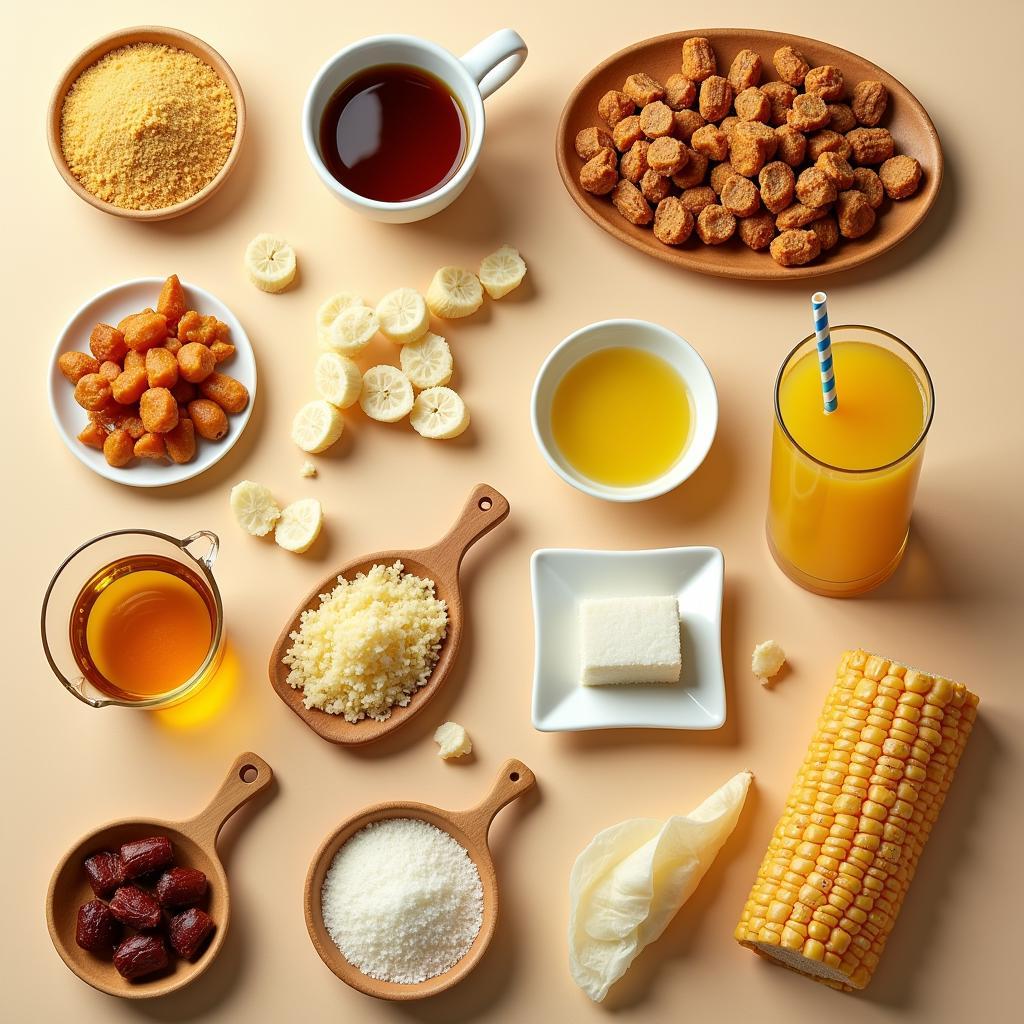From the moment it’s harvested to its final form on our plates, sugarcane offers a surprisingly diverse range of food products. Far beyond the familiar sweetness of table sugar, this versatile plant plays a key role in creating a wide variety of culinary delights. Join us as we delve into the fascinating world of Sugarcane Food Products, uncovering their origins, production processes, and the unique flavors they bring to our tables.
Beyond the Granules: Unveiling Sugarcane’s Sweet Secrets
While most people associate sugarcane with simple white sugar, the reality is far more intriguing. The journey begins with the extraction of sugarcane juice, a sweet liquid brimming with natural sugars. This juice serves as the foundation for a diverse range of products, each with its own distinct characteristics and culinary applications.
From Cane to Crystal: The Making of Sugar
The transformation of sugarcane juice into sugar is a fascinating process. It involves a series of steps including clarification, evaporation, crystallization, and centrifugation. The result is the granular sugar we all know and love, a staple ingredient in countless recipes across the globe.
Molasses: A Byproduct with Character
During the sugar-making process, a thick, dark syrup known as molasses is separated. This byproduct, rich in flavor and nutrients, finds its way into a variety of applications. From robust brown sugars to savory sauces and baked goods, molasses adds a depth of flavor that simple sugar cannot replicate.
Jaggery: Unrefined Sweetness from Asia
In many parts of Asia, sugarcane juice is transformed into jaggery, a traditional unrefined sugar. Unlike highly processed white sugar, jaggery retains valuable minerals and boasts a unique flavor profile that varies depending on the production method and region of origin. It’s a common ingredient in sweet and savory dishes, adding a distinct caramelized note.
Sugarcane Beyond Sweetness: A World of Culinary Applications
The versatility of sugarcane extends beyond its role as a sweetener. It features in a variety of culinary creations, both expected and surprising.
Beverages: Quenching Thirst with Sugarcane
Sugarcane juice, enjoyed fresh or in processed forms, is a popular beverage in many tropical regions. Its naturally sweet flavor and refreshing nature make it a perfect thirst quencher. Additionally, fermented sugarcane juice forms the base for various alcoholic beverages like rum and cachaça, enjoyed worldwide.
Snacks and Desserts: Indulgent Treats
Sugarcane plays a starring role in a range of sweet treats. From candies and chocolates to traditional desserts like sugarcane skewer (chao guo) and sugarcane juice popsicles, the options are endless. The unique flavor of sugarcane adds a touch of natural sweetness that complements a variety of ingredients.
Savory Applications: Beyond the Expected
While primarily known for its sweetness, sugarcane also finds its way into savory dishes. In some cuisines, jaggery is used to balance spicy or sour flavors, adding complexity to curries, stews, and sauces. Its unique taste profile adds a layer of depth and intrigue to savory preparations.
 Variety of Sugarcane Food Products
Variety of Sugarcane Food Products
Sugarcane and Sustainability: A Sweet Future?
As consumers become increasingly aware of the environmental impact of their food choices, the sustainability of sugarcane production comes under scrutiny. While challenges exist, the industry is making strides towards more sustainable practices.
The Environmental Impact of Sugarcane
Sugarcane cultivation can have environmental implications, including deforestation, water usage, and the use of fertilizers and pesticides. However, compared to other crops, sugarcane is relatively efficient in converting sunlight into energy, making it a potentially sustainable source of sugar.
Sustainable Sugarcane Initiatives
Efforts are underway to promote sustainable sugarcane production. These include:
- Improving agricultural practices: Implementing water conservation techniques, reducing reliance on chemical inputs, and promoting biodiversity.
- Investing in research and development: Exploring new sugarcane varieties with higher yields and resistance to pests and diseases.
- Promoting fair trade practices: Ensuring fair wages and working conditions for farmers and workers in the sugarcane industry.
Conclusion: Appreciating the Sweet Versatility of Sugarcane
From the familiar sweetness of table sugar to the unique flavors of jaggery and molasses, sugarcane food products offer a world of culinary possibilities. As we learn more about this versatile plant and strive for sustainable production practices, we can continue to enjoy the sweet bounty of sugarcane for generations to come.
FAQs about Sugarcane Food Products:
1. Is sugarcane healthy?
Sugarcane in its natural form, such as sugarcane juice, can be a good source of nutrients. However, processed sugarcane products like white sugar should be consumed in moderation as part of a balanced diet.
2. What is the difference between jaggery and brown sugar?
While both are unrefined sugars, jaggery is made solely from sugarcane juice, while brown sugar is typically white sugar with molasses added back in. Jaggery tends to have a stronger flavor and a slightly chewier texture.
3. What are the environmental concerns related to sugarcane production?
The main concerns include deforestation for sugarcane plantations, water usage for irrigation, and the use of fertilizers and pesticides. However, sustainable sugarcane farming practices aim to address these issues.
4. What are some popular sugarcane-based beverages besides sugarcane juice?
Other than fresh juice, sugarcane is used to make various drinks like sugarcane juice with lemon and ginger, sugarcane molasses tea, and alcoholic beverages like rum and cachaça.
5. How can I incorporate more sustainable sugarcane products into my diet?
Look for fair trade certified sugar and molasses, and consider trying jaggery as a natural sweetener. Additionally, be mindful of your overall sugar intake.
Need help with food packaging solutions? Contact us at Phone Number: 02437655121, Email: [email protected] or visit our address at 3PGH+8R9, ĐT70A, thôn Trung, Bắc Từ Liêm, Hà Nội, Việt Nam. Our customer service team is available 24/7. For more information on sustainable food containers and green food industries, check out our website. You can also learn about our fast food packaging and clamshells for food options.